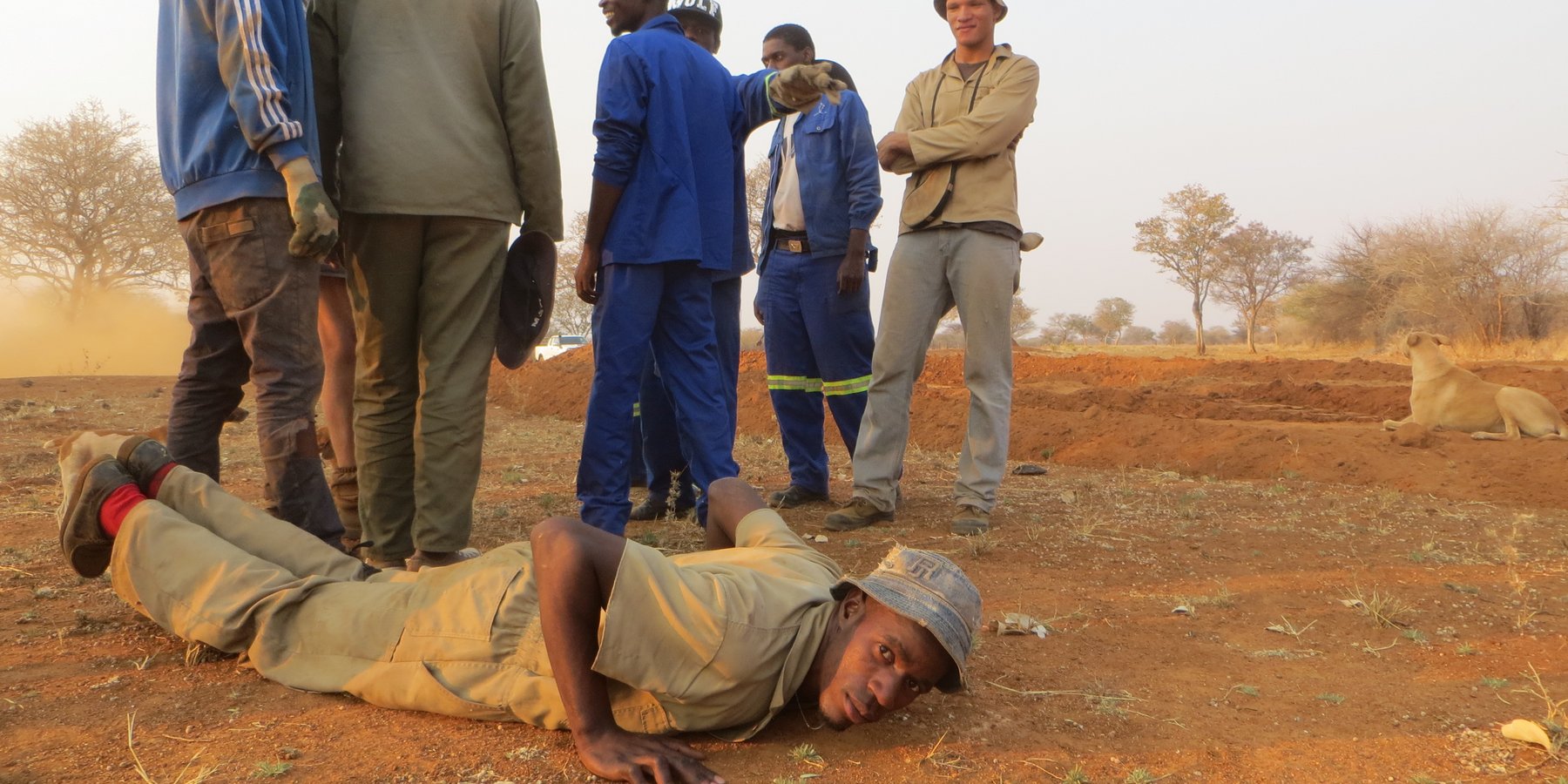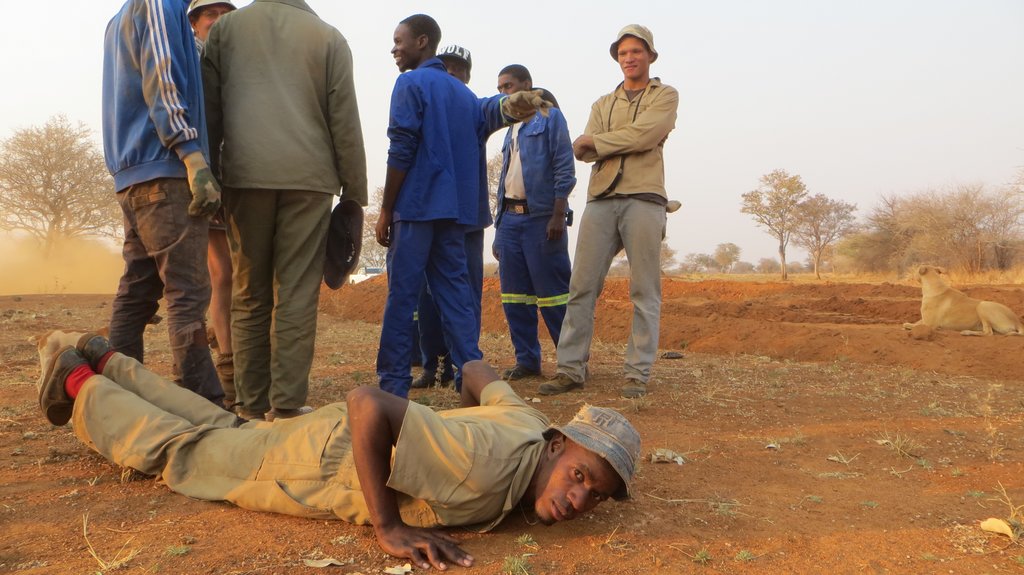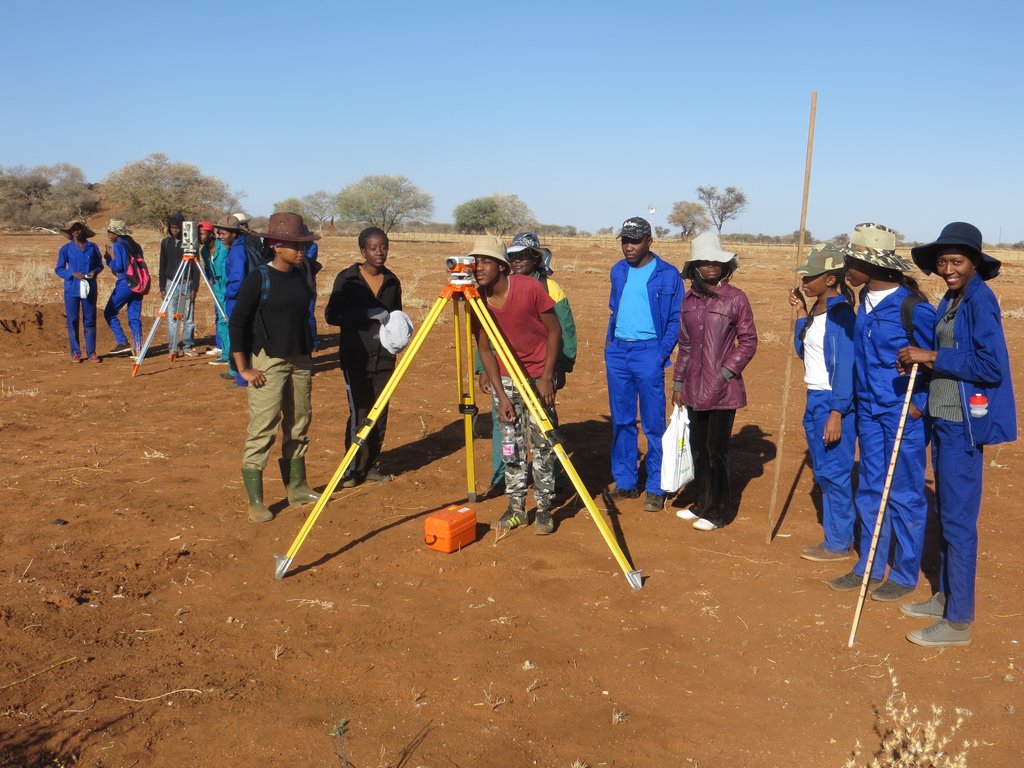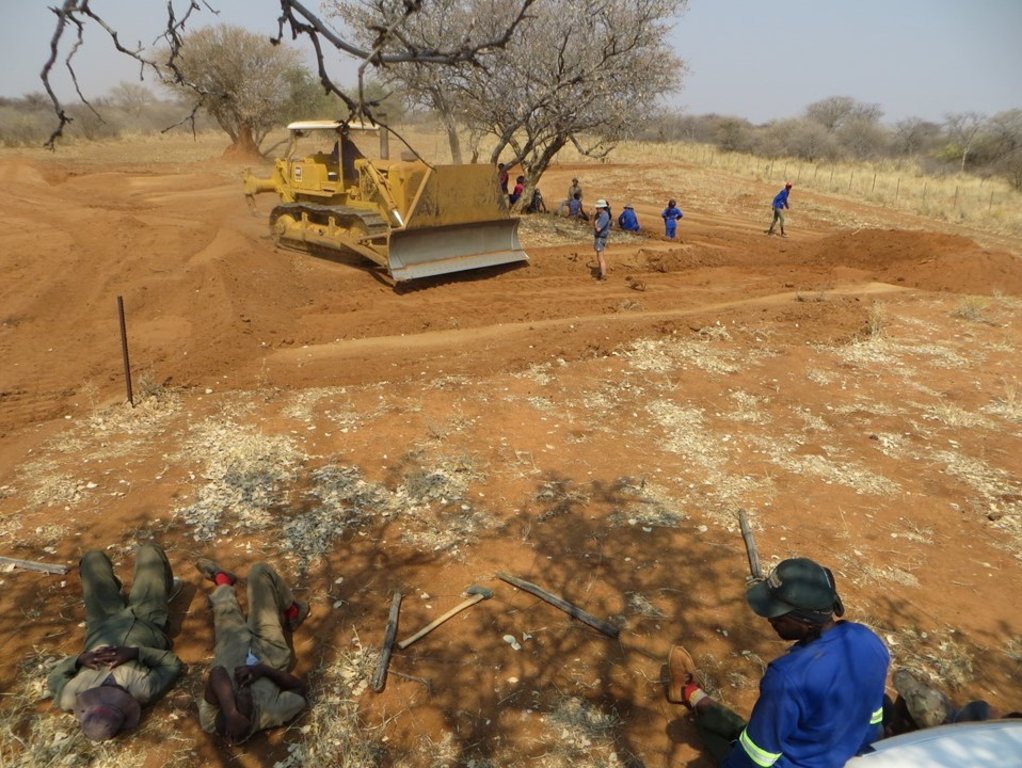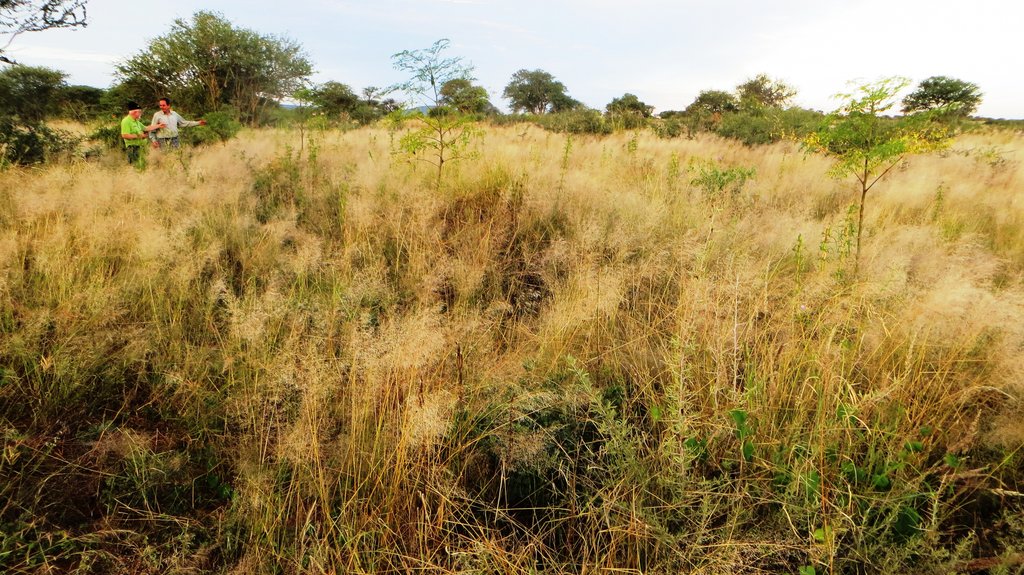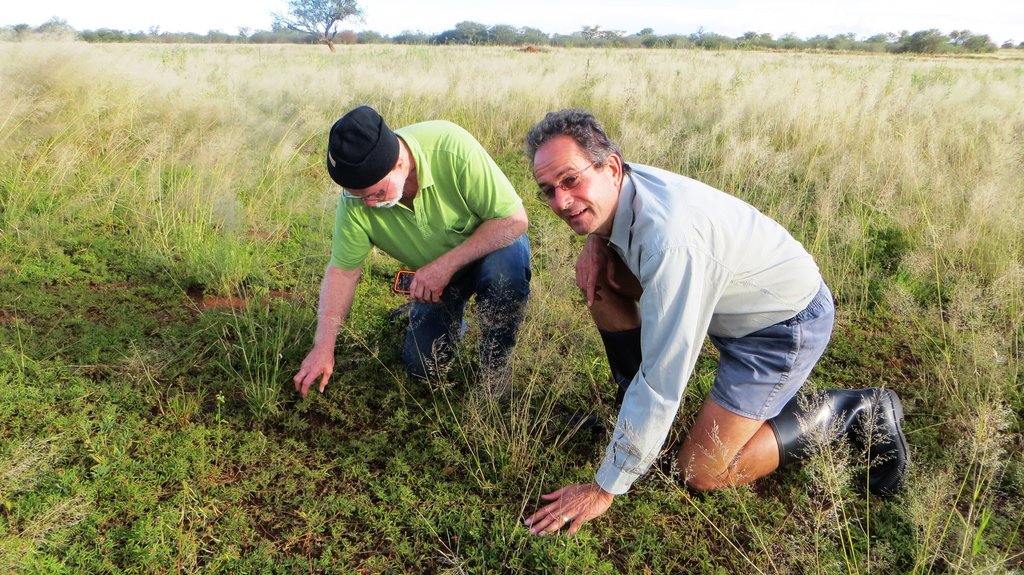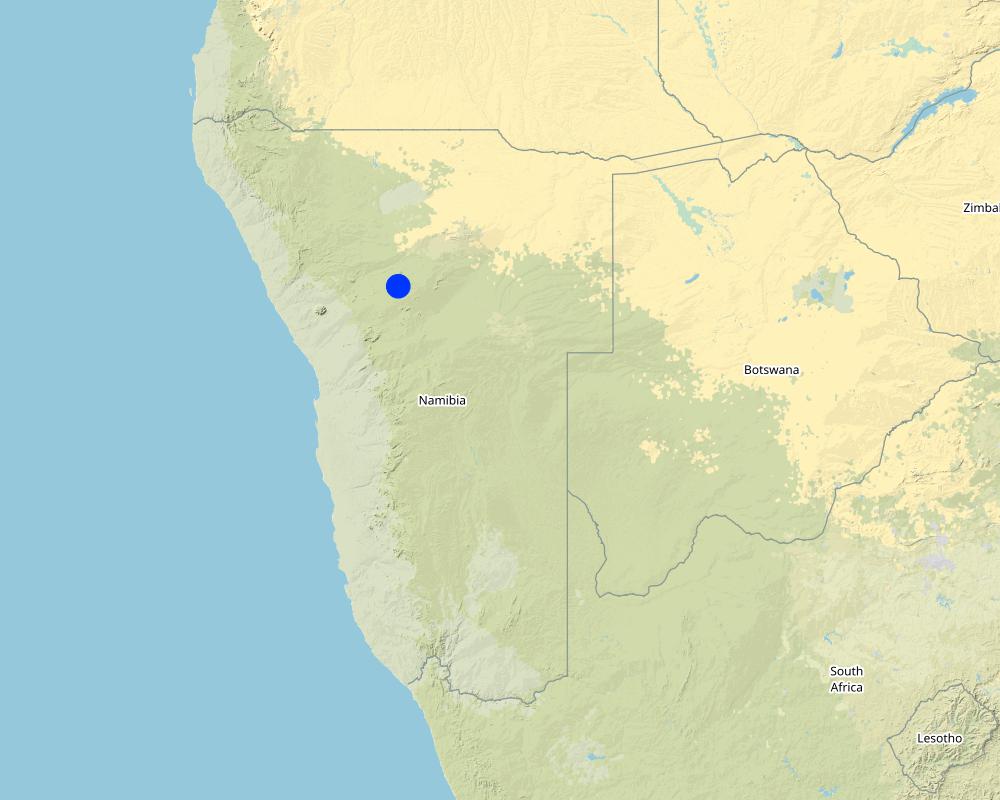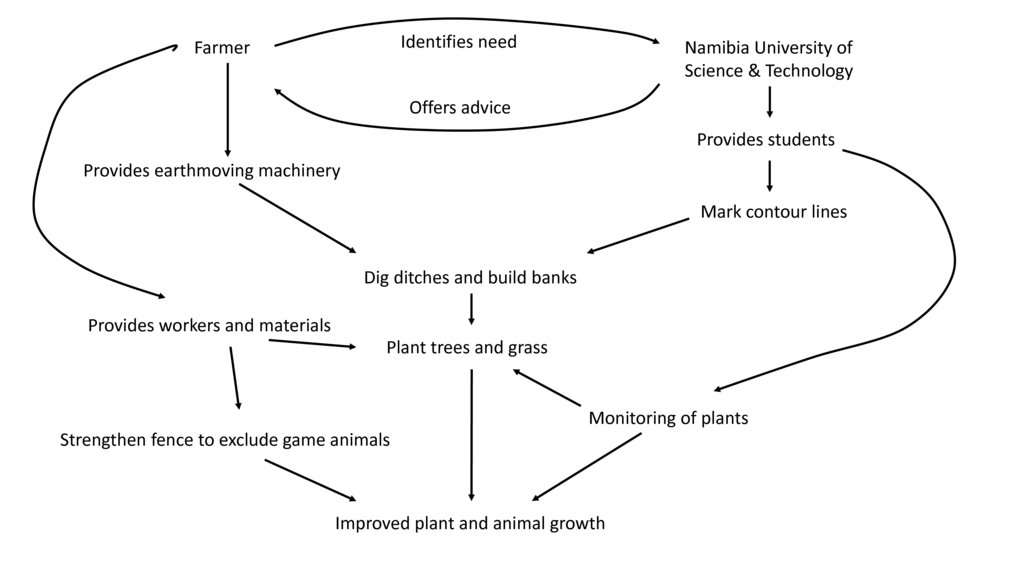Arrangements to convert degraded rangeland into fruitful landscape [纳米比亚]
- 创建:
- 更新:
- 编制者: Ibo Zimmermann
- 编辑者: –
- 审查者: Rima Mekdaschi Studer, Joana Eichenberger
Otjikunino
approaches_2847 - 纳米比亚
查看章节
全部展开 全部收起1. 一般信息
1.2 参与方法评估和文件编制的资源人员和机构的联系方式
土地使用者:
Kahl Uwe
+264 67 290004 / +264811486666
uwe2008@iway.na
Farm Middelplaats
P.O. Box 213 Otjiwarongo
纳米比亚
SLM专业人员:
Pringle Hugh
hpringle1@bigpond.com
Ecosystem Management Understanding
P.O. Box 8522 Alice Springs NT 0871
澳大利亚
有助于对方法进行记录/评估的项目名称(如相关)
Southern African Science Service Centre for climate change and Adaptive Land management (SASSCAL)有助于对方法进行记录/评估的项目名称(如相关)
Book project: Guidelines to Rangeland Management in Sub-Saharan Africa (Rangeland Management)有助于对方法进行记录/评估的机构名称(如相关)
Namibia University of Science and Technology ( NUST) - 纳米比亚有助于对方法进行记录/评估的机构名称(如相关)
German Federal Ministry of Education and Research (BMBF) - 德国1.3 关于使用通过WOCAT记录的数据的条件
(现场)数据是什么时候汇编的?:
2017
编制者和关键资源人员接受有关使用通过WOCAT记录数据的条件。:
是
1.4 SLM技术问卷的参考
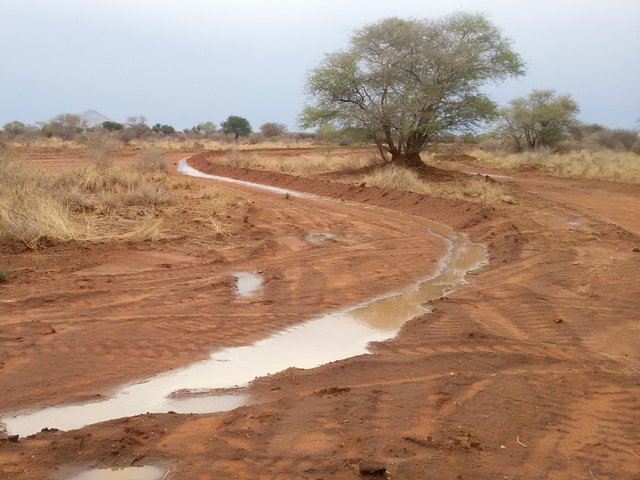
Infiltration ditches and ponding banks [纳米比亚]
Construction of contour ditches and ponding banks/ bunds to trap rainwater for infiltration. Improved growth of plants and replenishment of groundwater is promoted, while safely discharging excess water to avoid erosion. Integrated with other technologies that treat the root causes of rangeland degradation - rather than a stand-alone technology.
- 编制者: Ibo Zimmermann
2. SLM方法的描述
2.1 该方法的简要说明
Making arrangements between a commercial farmer and agriculture students to raise the productivity of rangeland - through managing runoff to grow multipurpose trees and bushes.
2.2 该方法的详细说明
该方法的详细说明:
The approach was to form linkages between the Namibia University of Science and Technology (NUST) and a large-scale commercial farmer to improve the efficiency of rainwater on rangeland. This was technically achieved by reducing runoff while increasing infiltration and transpiration. The objective is to share knowledge and experiences gained by the farmer to grow valuable woody plants, grass and herbs, which students could then apply elsewhere. Since the approach is applied in parts of the rangeland that experience high runoff, one of the first stages of implementation is to address the root causes of erosion - if not already in place. This could be through sound grazing management that provides sufficient rest for grasses to replenish food reserves after grazing. In turn this maintains grasses in a nutritious, leafy stage of growth. If infrastructure such as a farm road or dam has concentrated runoff water, then this too needs to be addressed, by spreading the runoff over gentle and wide portions of the landscape. Thereafter, an appropriate site is identified based largely on the local knowledge of the farmer. A variety of circumstances are taken into account to select the appropriate site, such as one that (a) receives considerable runoff rainwater, (b) has sufficiently deep soil for earthmoving and (c) proximity to where the farmer lives to enable more intensive management than that required by normal rangeland. Contour lines and gentle gradients are then laid out, whether by dumpy or laser level as was done by NUST students, or generated by analysis of aerial photographs taken by drone. Earthmoving equipment is then used for digging ditches and raising bunds or ponding banks to harvest rainwater. For smaller areas or where labour is plentiful, the contour ditches can be dug by hand – as was done by students on the campus of Katutura Youth Enterprise Centre (KAYEC) in Windhoek. After enough rain had fallen to sufficiently moisten the soil below contour ditches, tree seedlings were planted. This was done by farm workers and students at both the Middelplaats farm and KAYEC. Trees included large canopy species, shorter thornless types for “chop and drop” mulching and those that produce fruits or edible leaves. While the banks become crucial fertile patches in this arid landscape, they also act as broad barriers to sheet flow, slowing it down and increasing infiltration rates locally. Thus degraded “leaky landscapes” turn into “sponge landscapes” and restore deeper and more persistent soil moisture. The greatest cost, for earthmoving, was borne by the farmer. NUST paid for its students to visit the farm, sometimes supported by the landscape literacy project of SASSCAL funded by the German BMBF, which also brought in a technical advisor.
2.3 该方法的照片
2.4 该方法的视频
注释、简短说明:
Only a short section in the film from 18m07s to 19m15s
https://www.youtube.com/watch?v=6C4V_Cib8ts
日期:
08/04/2015
位置:
Farm Middelplaats and KAYEC campus, both in Namibia
摄影师的名字:
Andrew Botelle
2.5 采用该方法的国家/地区/地点
国家:
纳米比亚
区域/州/省:
Otjozondjupa
有关地点的进一步说明:
Farm Middelplaats
注释:
The point is at the homestead of Farm Middelplaats
Map
×2.6 该方法的开始和终止日期
注明开始年份:
2014
终止年份(若不再采用该方法):
1900
2.7 方法的类型
- 最近的本地倡议/创新
2.8 该方法的主要目的/目标
To make arrangements between a university and a farmer to improve rainwater efficiency in rangeland for growing valuable trees, grass and herbs for multiple use.
2.9 推动或妨碍实施本办法所适用的技术的条件
社会/文化/宗教规范和价值观
- 阻碍
Viewed with scepticism by some conventional farmers, who do not believe that rainwater harvesting can be cost-effective in rangeland.
财务资源和服务的可用性/可得性
- 阻碍
May be difficult to convince lenders of repayment potential.
机构设置
- 启动
The Namibia University of Science and Technology appreciates the valuable experience that its students can gain through this approach.
参与者的的协作/协调
- 启动
A trustworthy relationship has developed.
法律框架(土地使用权、土地和水使用权)
- 启动
Freehold land is being used.
土地治理(决策、实施和执行)
- 启动
Under control of willing farmer at Middelplaats.
- 阻碍
Engineers dug a trench at KAYEC to drain water off the land, thus defeating the purpose of rainwater harvesting ditches constructed by students.
了解SLM,获得技术支持
- 启动
There is willingness to gain further experience through experimentation
市场(购买投入,销售产品)和价格
- 启动
There is demand for the diverse products from fruitful landscapes.
工作量、人力资源可用性
- 启动
Farmer has access to earthmoving equipment with good operators.
- 阻碍
A road grader is not big enough for the job. The ideal machine is a CAT 14 bulldozer.
3. 相关利益相关者的参与和角色
3.1 该方法涉及的利益相关者及其职责
- 当地土地使用者/当地社区
Farmer.
Implements the activities.
- SLM专家/农业顾问
Two staff of the Namibia University of Science and Technology (NUST).
Advise on technicalities.
- 研究人员
Students of the Namibia University of Science and Technology (NUST).
Monitoring effectiveness of the technology.
- 教师/学龄儿童/学生
Classes of students of the Namibia University of Science and Technology (NUST).
Mark out contour lines where the technology is to be implemented.
- 国际组织
Southern African Science Service Centre for climate change and Adaptive Land management.
Funds an international advisor and students to participate in the project.
3.2 当地土地使用者/当地社区参与该方法的不同阶段
| 当地土地使用者/当地社区的参与 | 指定参与人员并描述活动 | |
|---|---|---|
| 启动/动机 | 互动 | Farmer requested advice from NUST and discussions took place. |
| 计划 | 互动 | A plan was drawn up through collaboration between farmer and advisers. |
| 实施 | 互动 | NUST students marked out contour lines. Farmer organised construction of infrastructure, planting of trees and their irrigation. |
| 监测/评估 | 互动 | Farmer keeps records of activities and students track tree survival and growth. |
3.3 流程图(如可用)
具体说明:
Linkages between farmer and university to convert rangeland into fruitful landscape.
作者:
Ibo Zimmermann
3.4 有关SLM技术选择的决策
具体说明谁有权决定选择要实施的技术:
- 所有相关参与者,作为参与式方法的一部分
解释:
The farmer of Middelplaats asked for advice from NUST, discussions were held, a plan was jointly drafted, followed by implementation by both farmer and students and advisers of NUST. Informal reviews are held annually where key issues are discussed and the project is “tweaked”.
明确做出决策的依据:
- 对充分记录的SLM知识进行评估(基于证据的决策)
- 研究结果
- 个人经验和意见(无记录)
- External experts' visits and suggestions
4. 技术支持、能力建设和知识管理
4.1 能力建设/培训
是否为土地使用者/其他利益相关者提供培训?:
是
明确受训人员:
- 土地使用者
- 现场工作人员/顾问
- Students
培训形式:
- 在职
- 课程
涵盖的主题:
Theory of rangeland science, water cycling and landscape literacy. Practical observational skills and use of dumpy and laser levels.
注释:
The farmer was trained in planning banks with a laser level, as were two staff in marking contour lines. The machine operator was trained in earthworks.
4.2 咨询服务
土地使用者有权使用咨询服务吗?:
是
指明是否提供了咨询服务:
- 在土地使用者的土地上
说明/注释:
The farmer could potentially offer an advisory service to other farmers based on experiences gained.
4.3 机构强化(组织发展)
是否通过这种方法建立或加强了机构?:
- 否
4.4 监测和评估
监测和评估是该方法的一部分吗?:
是
若是,该文件是否用于监测和评估?:
否
4.5 研究
研究是该方法的一部分吗?
是
明确话题:
- 经济/市场营销
- 生态学
提供进一步的细节,并指出是谁做的研究:
Small research projects are carried out by students of the Namibia University of Science and Technology to fulfil requirements for their course work.
5. 融资和外部物质支持
5.1 该方法中SLM组成部分的年度预算
如果不知道准确的年度预算,请给出一个范围:
- 2,000-10,000
注释(例如主要的资助来源/主要捐助者):
Mostly paid for by farmer, for operation of earthmoving equipment, which will not need to be repeated annually. A small amount for fieldwork by students and advisors paid from SASSCAL research funds.
5.2 为土地使用者提供财政/物质支援
土地使用者是否获得实施该技术的财政/物质支持?:
否
5.3 对特定投入的补贴(包括劳动力)
- 其它
| 其它(具体说明) | 程度如何 | 对补贴做出具体说明 |
|---|---|---|
| Marking of contour lines | Done as part of student training |
如果土地使用者的劳动力是一项重要的投入,那么是不是:
- 以现金支付
注释:
Fully paid by farmer at Middelplaats, but provided at KAYEC by students as part of their training.
5.4 信用
是否根据SLM活动的方法给予信用值?:
否
5.5 其它激励或手段
是否有其他激励措施或工具用于促进SLM技术的实施?:
是
如果是,请具体说明:
Advice was provided on implementation, and contour lines were marked out by students.
6. 影响分析和结论性陈述
6.1 方法的影响
该方法是否有助于当地土地使用者,提高利益相关者的参与度?:
- 否
- 是,很少
- 是,中等
- 是,支持力度很大
Only one farmer and his workers have been deeply involved. Others have been briefly exposed to the project.
这种方法是否有助于基于证据的决策?:
- 否
- 是,很少
- 是,中等
- 是,支持力度很大
Records of tree survival determined the need for initial irrigation.
该方法是否帮助土地使用者实施和维护SLM技术?:
- 否
- 是,很少
- 是,中等
- 是,支持力度很大
By advising the farmer at different stages of implementation.
该方法是否提高了SLM的协调性和成本效益?:
- 否
- 是,很少
- 是,中等
- 是,支持力度很大
At a key meeting it was agreed that grazing pressure from horses and wildlife was holding back the project.
该方法是否提高了土地使用者实施土地管理的知识和能力?:
- 否
- 是,很少
- 是,中等
- 是,支持力度很大
Experience gained by farmer and workers, and exposure to some other farmers.
该方法是否提高了其他利益相关者的知识和能力?:
- 否
- 是,很少
- 是,中等
- 是,支持力度很大
NUST students gained experience and understanding.
该方法是否改善了性别平等并赋予女性权力?:
- 否
- 是,很少
- 是,中等
- 是,支持力度很大
Students who participated included many females.
该方法是否改善了粮食安全/改善了营养?:
- 否
- 是,很少
- 是,中等
- 是,支持力度很大
Growth of fruit/edible leaf/fodder trees, such as Moringa oleifera, and improved forage.
该方法是否改善了供水和卫生条件?:
- 否
- 是,很少
- 是,中等
- 是,支持力度很大
Improved infiltration replenishes groundwater, which is used by both people and animals for drinking, and lush forage reduces drinking by livestock.
该方法是否提高了土地使用者适应气候变化/极端情况和减轻气候相关灾害的能力?:
- 否
- 是,很少
- 是,中等
- 是,支持力度很大
Improved rainwater -use efficiency on small part of farm.
该方法是否会带来就业、收入机会?:
- 否
- 是,很少
- 是,中等
- 是,支持力度很大
Saleable products such as Moringa leaves.
6.2 土地使用者实施SLM的主要动机
- 增加生产
Grass and trees grow better where rainwater infiltrated
- 增加利润(能力),提高成本效益比
More of better quality forage
- 减少土地退化
Better plant cover and soil biology
- 降低灾害风险
Improved buffering against drought
- 环境意识
By students and farm workers are exposed to the approach
- 提高SLM知识和技能
By students and farm workers are exposed to the approach
- 美学改进
Less bare ground and a more diverse landscape with reduction in extremes of temperature
6.3 方法活动的可持续性
土地使用者能否维持通过该方法实施的措施(无外部支持的情况下)?:
- 是
若是,请说明如何维持:
The farmer will continue to finance the maintenance work, the costs of which are expected to be covered by the increase in production.
6.4 该方法的长处/优点
| 土地使用者眼中的长处/优势/机会 |
|---|
| Advice from the university is appreciated. |
| Marking out of contour lines by students is appreciated. |
| 编制者或其他关键资源人员认为的长处/优势/机会 |
|---|
| Students gain useful experience on the farm. |
6.5 该方法的弱点/缺点以及克服它们的方法
| 土地使用者认为的弱点/缺点/风险 | 如何克服它们? |
|---|---|
| Students are not always available at the optimal times of the year. | By training farm workers to mark out contour lines. |
| 编制者或其他关键资源人员认为的弱点/缺点/风险 | 如何克服它们? |
|---|---|
| Students might make mistakes, as they are still learning. | Prepare students well and check their work. |
7. 参考和链接
7.1 方法/信息来源
- 实地考察、实地调查
As part of ongoing cooperation
- Participation in fieldwork and e-mail communication with land user and specialist
Participation in fieldwork and e-mail communication with land user and specialist
7.2 参考可用出版物
标题、作者、年份、ISBN:
Back from the brink, Andrews, 2006, 0-7333-1962-9
可以从哪里获得?成本如何?
https://www.amazon.com/Back-Brink-Australias-Landscape-Saved/dp/0733319629 $37
标题、作者、年份、ISBN:
Beyond the brink, Andrews, 2008, 978-0733324109
可以从哪里获得?成本如何?
https://www.amazon.com/Beyond-Brink-Sustainable-Australian-Landscape/dp/073332410X $59
标题、作者、年份、ISBN:
Rainwater harvesting for drylands and beyond: Vol 1 – Guiding principles to welcome rainfall into your life and landscape, Lancaster, 2009, 978-0-9772464-0-3
可以从哪里获得?成本如何?
https://www.amazon.com/Rainwater-Harvesting-Drylands-Beyond-2nd/dp/0977246434 $20
7.3 链接到网络上可用的相关信息
标题/说明:
Principles of natual sequence farming
URL:
http://www.nsfarming.com/principles.html
标题/说明:
Rangeland Rehydration
URL:
www.emulandrecovery.org.au
链接和模块
全部展开 全部收起链接

Infiltration ditches and ponding banks [纳米比亚]
Construction of contour ditches and ponding banks/ bunds to trap rainwater for infiltration. Improved growth of plants and replenishment of groundwater is promoted, while safely discharging excess water to avoid erosion. Integrated with other technologies that treat the root causes of rangeland degradation - rather than a stand-alone technology.
- 编制者: Ibo Zimmermann
模块
无模块


